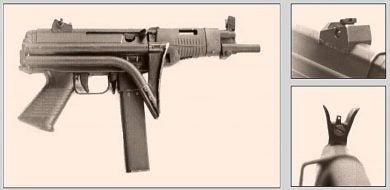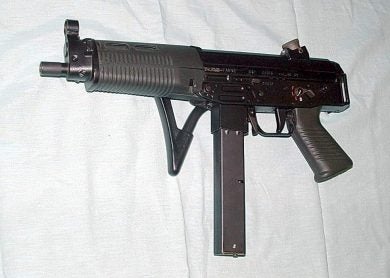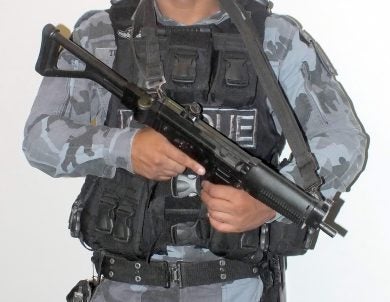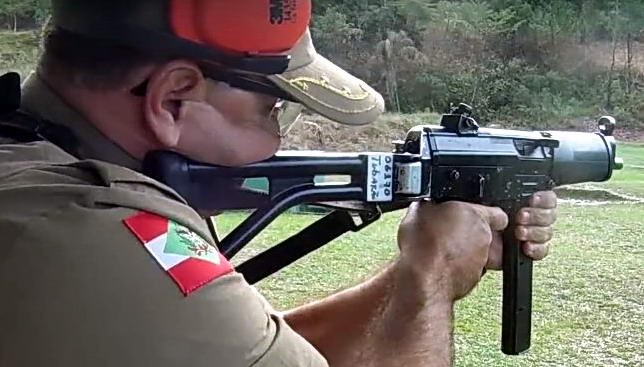Having manufactured its MT-12, MT-12A and MT-12AD 9x19mm submachine guns for several years, Forjas Taurus started looking at new designs to replace those weapons generally based on the Italian Beretta M12 that had been created by Domenico Salza and entered production in the early 1960s. Once again, the Brazilian company’s eyes turned to an out-of-the-country source, this time, Chile’s FAMAE – Fábricas y Maestranzas del Ejército. That State-owned company signed an agreement with Switzerland’s SIG – Schweizenche Industrie Gesellschaft concern in the 1980s covering the license manufacture of the 5.56x45mm SG 540-1 and SG 543-1 rifles as well as of the 7.62x51mm SG 542-1 model, the whole set of engineering drawings and production machinery being provided.
It just so happened that the Chilean engineers decided to also use the SIG rifles as a basis for a 9x19mm submachine gun called the SAF (Sub Ammetralladora FAMAE), a prototype being ready in September, 1989, and series production starting by 1990-91. Initial deliveries were for the Policía de Investigaciones de Chile (Investigations Police of Chile), but the gun was later supplied to the Carabineros (the famous uniformed national police) and the armed forces.

Rare images of the very first SAF submachine gun completed in 1989, with the early sights fitted.

Later production examples of the 9x19mm SAF with the two types of stocks available.
In 1999, Taurus signed an agreement with FAMAE covering a joint production program for a .40 Smith & Wesson-chambered version of the SAF for sales to Brazilian LE agencies, which had become fully committed to using that cartridge for pistols and subguns. A prototype gun was submitted to and approved by certification tests carried out by the Army’s Campo de Provas da Marambaia (Marambaia Proving Grounds), in Rio de Janeiro, so that local manufacture and sales could follow. Most of the weapon’s components came, in fact, from Chile, with final assembly taking place at the Taurus industrial facilities in Porto Alegre, Rio Grande do Sul State. Under the designation MT40 (alternatively, MT-40), the gun was eventually acquired by several State Military and Civil Police agencies.
For the record, Taurus also had a 9x19mm version, designated MT9 and externally undistinguishabe, available at the time with the clear purpose of reaching the local military market, but no sales were ever made. Oh, yeah: its cyclic rate of fire was even higher, at 1,300 rounds per minute!

The Taurus-FAMAE MT40 example (serial number “00015”) tested for product certification by Brazilian Army’s Marambaia Proving Grounds, in Rio de Janeiro. Note the re-shaped handguard, as compared to the 9x19mm SAF.

Right side view of same gun, stock extended. The ambidextrous fire selector lever above the pistol grip has the settings “S” (Safe), “1” (Semi-auto), “L” (Limited 3-round bursts, and “R” (Auto), the cyclic rate of fire being a seldom-appreciated 1,200 rounds per minute.
In brief, the MT40 is a blowback-operated SMG firing from the closed-breech position via a hammer+floating firing pin action. A brief visual examination will show that the lower receiver and the pistol grip/trigger assembly, plus the foldable stock, come very straight from the SIG/FAMAE rifles that originated the subgun. The barrel fitted is 200mm long, overall length being 677mm, or 421mm, with the stock folded to the right. With a full 30-round magazine, weight is 3.7kg.

MT40s in range use by members of PMSC – Polícia Militar de Santa Catarina (Santa Catarina State Military Police). It is believed that around ten Brazilian police agencies acquired the bi-national submachine gun.

A Taurus-FAMAE MT40 in the inventory of PMERJ – Polícia Militar do Estado do Rio de Janeiro (Rio de Janeiro State Military Police), as shown by the urban camo uniform of the force’s Batalhão de Choque (Shock Battalion). The foldable stock of most production guns differs from that of the original Chilean model.

This MT40 from the inventory of the Paraná State Civil Police uses the original, flimsier SIG-based folding stock.

This particular specimen of the MT40, apparently from the São Paulo State Civil Police, is fitted with a muzzle device (recoil compensator, accorrding to Taurus literature) of the type used in the semi-auto, long-barrel CT40 carbine. The shape of the fire selector lever is somewhat different from that of the “00015” previously illustrated.
A .40 S&W semi-auto carbine derivative was developed by FAMAE after the SAF submachine gun was in production, a relatively simple step involving the necessary changes in the firing mechanism and the addition of a 410mm long barrel to the upper receiver and giving it an elongated handguard. This was included in the bi-national agreement with Taurus, production starting in about 2002. It was primarily aimed at the LE and penitentiary guard markets, orders eventually coming from different States in Brazil, not surprisingly, including those having MT40 SMGs in their inventories. Another user for some time was the PRF – Polícia Rodoviária Federal (Federal Highway Police), which eventually donated 21 weapons to PCMS – Polícia Civil do Mato Grosso do Sul (Mato Grosso do Sul State Civil Police) in 2017.

Seen here in a range training session in the hands of a PMPR – Polícia Militar do Paraná (Paraná State Military Police) sergeant, the CT40 is using a 30-round magazine. Note flash hider fitted to the 410mm barrel.

The business end of a PMSC (Santa Catarina State Military Police) CT40 carbine, emphasizing the weapon’s flash hider and the protected front sight. Basic data: length, overall, 890mm; length, stock folded, 630mm; weight with loaded 30-rd magazine, 4kg.

This member of São Paulo State’s Civil Police has given his issue CT40 carbine a holographic sight. The stock fitted is the earlier SIG type.
Higher-res pix: https://imgur.com/a/HGAdu
 Your Privacy Choices
Your Privacy Choices
